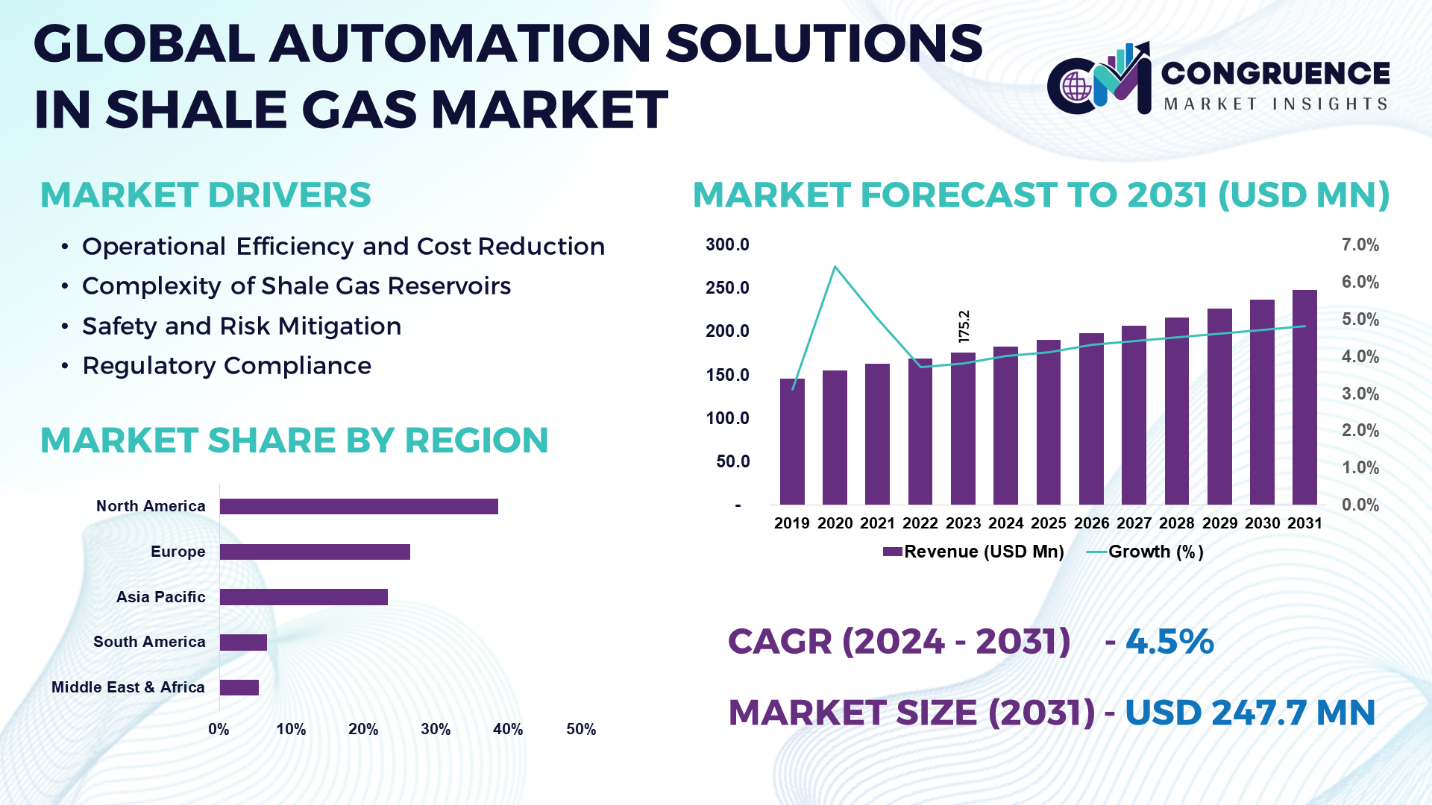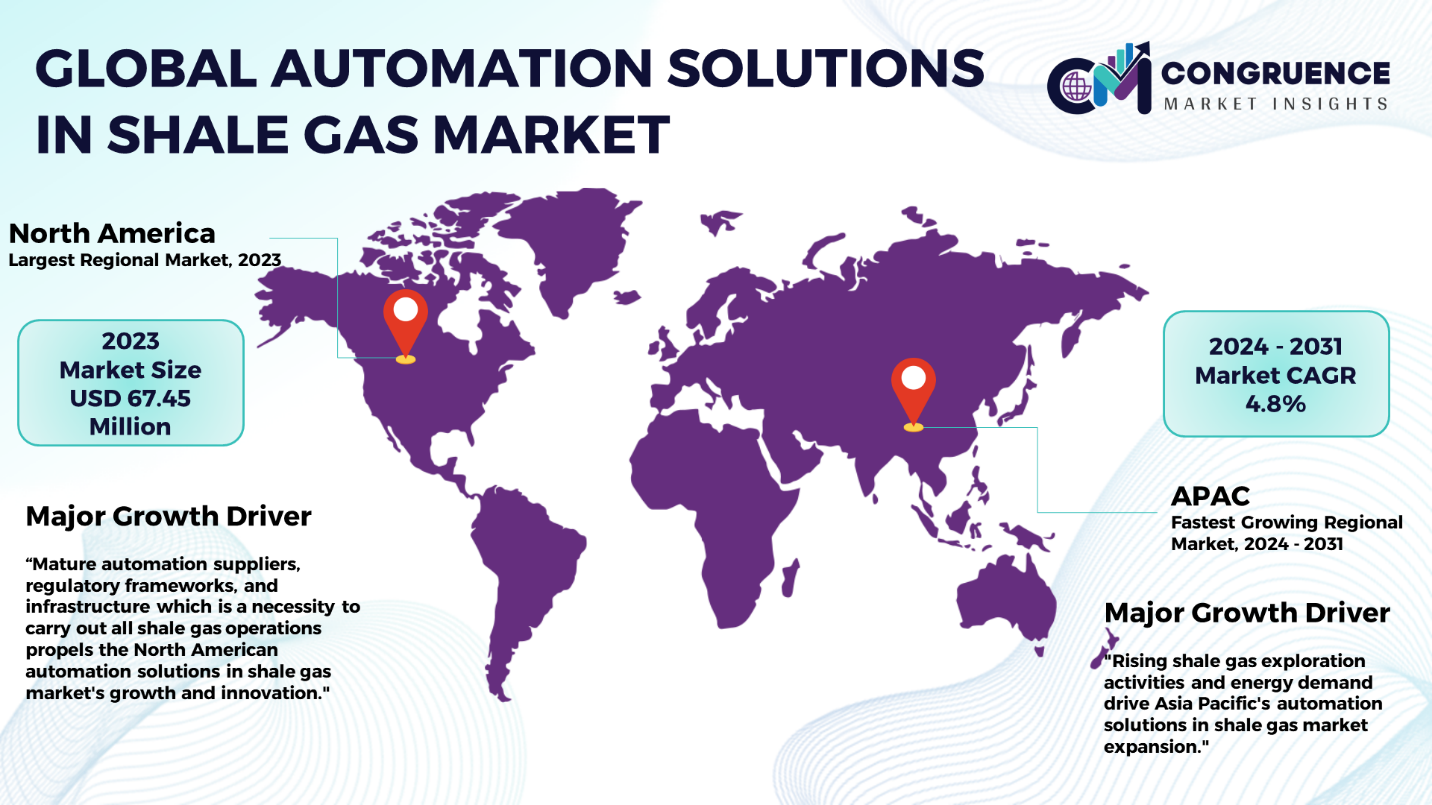Reports
The Global Automation Solutions in Shale Gas Market was valued at USD 175.2 Million in 2023 and is anticipated to reach a value of USD 247.7 Million by 2031 expanding at a CAGR of 4.5% between 2024 and 2031.
Shale gas extraction has become a major player in the global energy market, with a lot of reserves and the possibility of being energy independent. The shale gas operations in this market are rapidly evolving, and automation tools play a vital part in making the operations more productive, safe, and profitable. Automation technologies such as supervisory control and data acquisition (SCADA), distributed control systems (DCS), and programmable logic controllers (PLC) form the foundation on which shale gas operators expand optimization and efficiency levels through drilling, production, and distribution. With these solutions, real-time monitoring, predictive maintenance, and remote control features can be performed, thereby minimizing operational risks, reducing downtime, and maximizing production yields. Furthermore, automation provides regulators with ease of compliance and aids in environmental protection as well as running through daily operations. The call for shale gas increases around the world, mainly due to rising energy demand, technological progress, and favorable government policy. Thus, given the amount of shale gas consumption, the market for automation-based solutions is set for considerable development. These companies are keen on innovation, collaboration, and strategic partnerships to deal with changing customer needs and emerging opportunities in the shale gas industry landscape.

Automation Solutions in Shale Gas Market Major Driving Forces
Operational Efficiency and Cost Reduction: Automation selections smooth shale gas production by enhancing processes such as drilling and hydraulic fracturing, e.g., and, as a result, there is efficiency and cost reduction.
Complexity of Shale Gas Reservoirs: This fracturing of the gas ore creates very low permeability and heterogeneous geology, which makes it necessary to use sophisticated automation technologies to enhance reservoir management and the oil production process.
Safety and Risk Mitigation: AI-based solutions provide the mitigation of safety risks in shale gas operations by furnishing people with real-time intelligence of critical parameters, fault detection, and automatic shutdown in emergencies.
Regulatory Compliance: To satisfy stringent environmental standards, regulatory authorities performing inspections and probes obliged us to apply automation that would be used to keep track of requirements for air and water quality, emissions monitoring, and waste management regulations.
Automation Solutions in Shale Gas Market Key Opportunities
Technological Advancements: The number of opportunities is very high for the innovation and development of advanced automation solutions that will be tailored to the specific problems of shale gas extraction, including the complexity of the reservoir, the optimization of hydraulic fracturing, and environmental monitoring.
Integrated Solutions: An increasing number of customers’ demand for advanced automation suites that include drilling, output, and distribution stages in the analytical system. These suites provide easy integration, interoperability, and extensive data analysis at a control unit.
Data Analytics and Predictive Maintenance: The advancement of data analytics and predictive maintenance algorithms is the pathway that leads to boosting asset operation performance, reducing equipment downtime, and optimizing production efficiency at shale gas operations.
Automation Solutions in Shale Gas Market Key Trends
· The growing use of IoT and cloud-based automation solutions for real-time monitoring and control in shale gas operations is one of the main factors in automated monitoring and control in the shale gas industry.
· The area of predictive analytics, along with machine learning algorithms aimed at improving production oversight and reservoir flow, has taken center stage.
· Climbing tendency for blended automation stations providing centralized integration of drilling, production, and distribution processes.
· The emergence of shale gas exploration activities into new regions, coupled with the increasing demand for automation solutions that are designed to meet diverse geological and environmental conditions, is clear evidence of the fact that automation has brought a revolution to the drilling industry.
· Strong goals will be given to environmental monitoring as well as implementing regulatory compliance solutions that help minimize environmental impacts and guarantee sustainable shale gas exploration and extraction.
· Ensure remote monitoring and control systems for shale projects for safety and operation efficiency. The technology will be used in cases where personnel cannot be physically at the site, therefore enhancing safety and efficiency.
· Investment in cybersecurity measures to secure the critical infrastructure and data integrity in shale gas automation systems.
· Apply technological solutions, such as automation of difficult tasks within the gas shale business, to come up with new automation systems that are tailored to the operations` specific problems.
· One of the key activities is not only the performance of assets but also maintaining them in reference to the reduction of downtime and optimization of production in the shale gas operations.
· Digital twin technology for virtual modeling and simulation of shale gas reservoirs, wells, and production facilities to enhance performance and decision-making is one of the adoption applications.
Region-wise Market Insights
North America accounted for the largest market share at 38.5% in 2023 whereas, Asia Pacific is expected to register the fastest growth, expanding at a CAGR of 4.8% between 2024 and 2031.

The region-wise studies of automation solutions available in the shale gas industry are different, yet these regions have ample chances of growth in all of the different regions. North America is a creditable and powerful one, with the US shale gas revolution being the main driver in the energy sector. Since it has a huge amount of shale gas reserves and the latest drilling technologies, North America is currently the leader in shale gas extraction and automation usage. The level of automation in the region is driven by the ecosystem of mature automation suppliers, regulatory frameworks, and infrastructure, which is a necessity to carry out all shale gas operations. In Europe, specifically the United Kingdom and Poland, countries with the curiosity and potential exertions to shale gas resources are finding the demand for automation solutions to optimize the exploration of production processes. The Asia-Pacific region, which includes China and Australia, is a region with great potential for shale gas exploration. It is a region where automation solution providers can support the emerging shale gas exploration activities in the region. In addition to the case of the United States, the nations of Latin America, such as Argentina and Mexico, are also looking for shale gas, which leads to the need to automate performance so as to quicken operational availability and environmental safety. Moreover, the area of the Middle East and Africa, with its infant shale gas industry, provides the chance for automation solution suppliers to utilize their products to support the development of shale gas resources as well as infrastructure.
Market Competition Landscape
In this intense rivalry in automation solutions for the shale gas industry, many major companies are striving to occupy more share by means of technology, service offerings, and strategic partnerships to distinguish themselves. Established companies polarize the market with their wide range of automation solutions for pre-drilling and drilling processes, which are custom-made for shale gas exploration and production companies. These industry leaders who have made their careers in the oil and gas industry, have a global presence, and have also done research and development in this field are the ones who offer the integrated automation platforms that optimize the drilling, hydraulic fracturing, and production processes in the shale gas operations. Moreover, the emerging companies are innovators and play disruptor roles as well, particularly for niche offerings, and exploit their efficiency around their segment of clients. These businesses belong to new startups that develop newer solutions, customization, and customer-oriented products to meet the innovative ways and challenges of the shale gas industry. Collaboration and associations between automation solution providers, shale gas operators, and technology partners are also influential in this competitive landscape; they drive innovation and market expansion. Prominent players in the market include:
· Siemens AG
· ABB Ltd.
· Emerson Electric Co.
· Rockwell Automation, Inc.
· Yokogawa Electric Corporation
· Honeywell International Inc.
· General Electric Company
· Schneider Electric SE
· Mitsubishi Electric Corporation
· Hitachi, Ltd.
· Eaton Corporation plc
· Baker Hughes Company
· National Oilwell Varco, Inc.
· Schlumberger Limited
· Halliburton Company
|
Report Attribute/Metric |
Details |
|
Market Revenue in 2023 |
USD 175.2 Million |
|
Market Revenue in 2031 |
USD 247.7 Million |
|
CAGR (2024 – 2031) |
4.5% |
|
Base Year |
2023 |
|
Forecast Period |
2024 – 2031 |
|
Historical Data |
2019 to 2023 |
|
Forecast Unit |
Value (US$ Mn) |
|
Key Report Deliverable |
Revenue Forecast, Growth Trends, Market Dynamics, Segmental Overview, Regional and Country-wise Analysis, Competition Landscape |
|
Segments Covered |
· By Solution Type (SCADA, DCS, PLC, Predictive Analytics) · By Application (Drilling, Hydraulic Fracturing, Production Optimization) · By End-User (Oil Companies, Service Providers) |
|
Geographies Covered |
North America: U.S., Canada and Mexico Europe: Germany, France, U.K., Italy, Spain, and Rest of Europe Asia Pacific: China, India, Japan, South Korea, Southeast Asia, and Rest of Asia Pacific South America: Brazil, Argentina, and Rest of Latin America Middle East & Africa: GCC Countries, South Africa, and Rest of Middle East & Africa |
|
Key Players Analyzed |
Siemens AG, ABB Ltd., Emerson Electric Co., Rockwell Automation, Inc., Yokogawa Electric Corporation, Honeywell International Inc., General Electric Company, Schneider Electric SE, Mitsubishi Electric Corporation, Hitachi, Ltd., Eaton Corporation plc, Baker Hughes Company, National Oilwell Varco, Inc., Schlumberger Limited, Halliburton Company. |
|
Customization & Pricing |
Available on Request (10% Customization is Free) |
